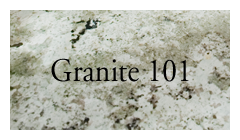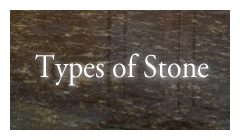Granite 101
Questions & Answers
How much does a granite countertop typically cost?
This is a frequently asked question and the answer varies. The cost depends on a number of things:
- The type of stone (difficulty in quarrying and shipping)
- Edging
- Backsplash
- Radius
(When stopping in for a rough estimate please bring a drawing of the area with measurements.)
What are "pits and fissures"?
Pits and fissures are a natural part of a stones make up. Pits are small spaces between the different crystalline structures. Fissures or "hairline cracks" are a natural result to the heating and cooling process during the stones formation and should not be confused with structural cracks that go through the entire slab. Some stones will have more of these natural characteristics than others. Pits & fissures are a normal part of stone and will not impair their function or durability.
Why is some stone more porous than others?
The porosity in stone differs due to the process and where in the world your stone was formed. Different areas are made up of different minerals.
Where does stone come from?
Stone is mined from different quarries throughout the world. A quarry is an open mine where stone or other material is extracted by blasting, cutting, or drilling.
Has my stone been sealed?
Apply a dime size drop of water to the top of your stone. Cover drop with a glass to prevent evaporation, let stand for 15 minutes. If your stone does not darken, it's most likely sealed against water-based stains. To test for oil resistance you may end up with an oil stain if your stone is not sealed, so take care when using any oil based substance.
Origin
Igneous Stone - Stone that was created from igneous rock was formed under intense heat typically produced by volcanoes. The magma gradually cooled to form stone. Igneous stones typically have small flecks of minerals consistently throughout them, although some may have a veining appearance. Igneous stones are typically hard and dense.
Sedimentary Stone - Sedimentary stone was formed when substance containing remains of organic matter was fused by intense pressure. Sedimentary stones may even contain fossils or other distinct features formed at the time of deposit.
Metamorphic Stone - Metamorphic stone was formed at extremely high pressures and or temperatures. The presence of swirls, linear patterns or banding is a key characteristic. Slate is a fine grained, metamorphic rock which splits into flat and almost smooth pieces. Marble is a metamorphic limestone that loses the fossils and other features during re-crystallization.
Composition
Silicates - Silicate stone is comprised of mostly quartz-like particles called silica (a colorless transparent solid that melts at a very high temperature). They are very dense and durable.
Calcium Carbonates - Calcium carbonate is a white crystalline solid, which is one of the most common natural substances. It's found in chalk, limestone, marble, and travertine. It's also in animal shell and bones. These stones were formed from the bodies of tiny fossilized creatures under pressure over millions of years and are generally softer, less durable, and more sensitive to acids than those composed of silicates.




